

{image_1} In an excavation that was conducted north of the Old City wall of Akko, a unique find was discovered from the Crusader period (13th century)—a hoard of 350 marble items.
Continue Reading »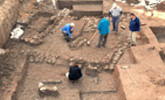
{image_1}
Tel Aviv is one of the new generations of Israeli cities, literally built out of the sand in the last century. However, archaeology shows that the Tel Aviv area was inhabited thousands of years ago, thanks in part to the discovery of the remains of a prehistoric building. The Israel Antiquities Authority (IAA) reported that the building is the oldest ever found in the area and is believed to be thousands of years older than the era of Abraham and the patriarchs.
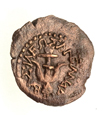
By Charleeda Sprinkle, Assistant Editor
{image_1}AFTER AN ARCHAEOLOGICAL DIG, it takes some time before all the data is collected and studied thoroughly. In the process, oftentimes, an archaeologist’s first summation of the site or finds changes. That was the case recently after researchers analyzed artifacts from excavations by Dr. Rudolph Cohen, retired Deputy Director of Israel Antiquities Authority (IAA), who worked in the region of the Negev for 25 years. When Horvat Ma’agurah, south of Beersheva, was first uncovered, Cohen believed it to be the remains of a Roman fourth-century fortress.
Continue Reading »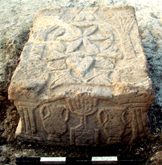
{image_1} A synagogue from the Second Temple period (50 BC–AD 100) was exposed in archaeological excavations the Israel Antiquities Authority (IAA) is conducting at a site where a new hotel is being constructed in Migdal (“Magdala” in Aramaic) on the Sea of Galilee. The main hall of the synagogue is c. 120 square meters [1,291 square feet] in area, and its stone benches, which served as seats for the worshippers, were built up against the walls of the hall. Its floor was made of mosaic, and its walls were treated with colored plaster (frescos).
Continue Reading »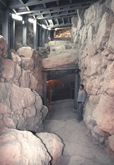
{image_1} WHAT APPEARS TO BE a fortified passageway at least 3,700 years old, leading to ancient Jerusalem’s water supply, has been uncovered in the City of David site outside Dung Gate of Jerusalem’s Old City. According to Dr. Ronny Reich, professor of archaeology at the University of Haifa and one of the leaders of the excavation, “This is the first time that such massive construction that predates the Herodian period has been discovered in Jerusalem.” The find puts ancient Jerusalem “more or less” on par as a city-state with other ancient sites, such as Shechem and Hebron.
Continue Reading »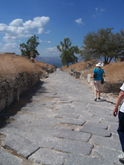
{image_1} AS BFP VOLUNTEERS IN ISRAEL, my friend Teri and I love to discover new places that are off the beaten tourist path. We’ve scrambled down narrow openings to hidden caves, hiked to a Crusader castle covered by overgrown brush, and participated in a dig at Dor, a little-known ancient seacoast town. This summer was no different. While driving along the eastern shore of the Sea of Galilee, Teri took a turn off the road up a 3.5 kilometer (2 mile), narrow, pitted road that zig-zagged up a foothill of the Golan Plateau, 350 meters (1,150 feet) above the lake. I was surprised to see a national park sign in the small parking lot and wondered why I’d never heard of it before. The sign at the main road said Susita, but it wasn’t marked there as a place of interest.
Continue Reading »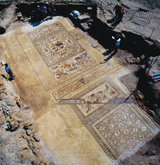
{image_1} IN A UNIQUE FIND in the plaster beneath a 1,700-year-old mosaic, Israel Antiquities Authority (IAA) conservators discovered the imprint of several feet and sandals. According to a press release from the IAA, Jacques Neguer, head of the IAA Art Conservation Branch, said, “The excitement here was great. It is fascinating to discover a 1,700-year-old personal mark of people who are actually like us, who worked right here on the same mosaic. We feel the continuity of generations here.”
Continue Reading »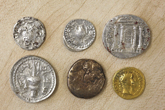
{image_1}
A COLLECTION OF 120 coins was unearthed in a cave in the Judean Hills not far from ancient Betar, where Jewish Bar-Kochba rebels took their last stand against the Romans in 135 AD. It is the largest cache of Bar-Kochba-era coins found in one location.
Continue Reading »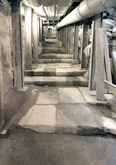
{image_1}
THE SOUTHERNMOST tip of Second Temple period-Jerusalem’s central thoroughfare was uncovered, revealing that era’s style of alternating wide and narrow steps.
Continue Reading »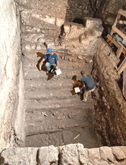
{image_1} A LARGE AND IMPRESSIVE MIKVEH (ritual bath) from the end of the Second Temple period was uncovered in an Israel Antiquities Authority (IAA) excavation within the Western Wall tunnels. The mikveh is part of one of the most magnificent structures from the Second Temple period ever to be uncovered. From an architectural and artistic standpoint, there are similarities between this structure and the three magnificent compounds that King Herod built on the Temple Mount.
Continue Reading »All logos and trademarks in this site are property of their respective owner. All other materials are property of Bridges for Peace. Copyright © 2025.
Website Site Design by J-Town Internet Services Ltd. - Based in Jerusalem and Serving the World.